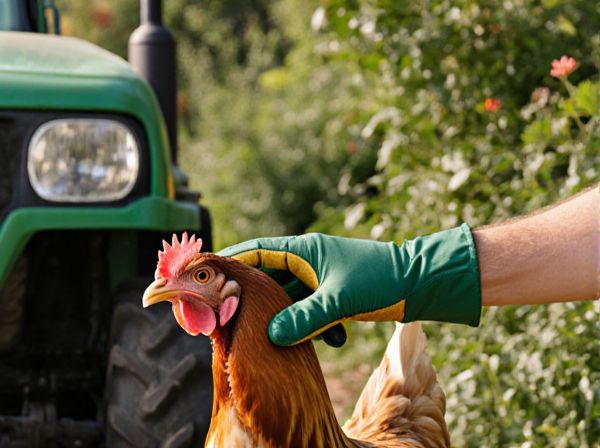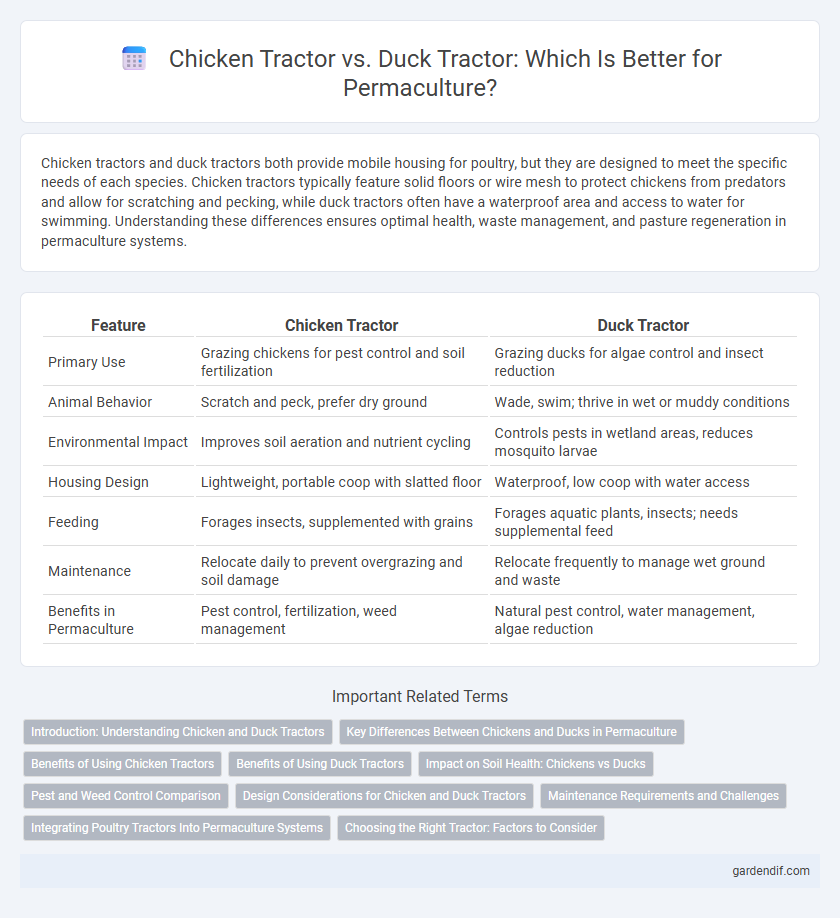
Chicken Tractor vs Duck Tractor Illustration
Chicken tractors and duck tractors both provide mobile housing for poultry, but they are designed to meet the specific needs of each species. Chicken tractors typically feature solid floors or wire mesh to protect chickens from predators and allow for scratching and pecking, while duck tractors often have a waterproof area and access to water for swimming. Understanding these differences ensures optimal health, waste management, and pasture regeneration in permaculture systems.
Table of Comparison
| Feature | Chicken Tractor | Duck Tractor |
|---|---|---|
| Primary Use | Grazing chickens for pest control and soil fertilization | Grazing ducks for algae control and insect reduction |
| Animal Behavior | Scratch and peck, prefer dry ground | Wade, swim; thrive in wet or muddy conditions |
| Environmental Impact | Improves soil aeration and nutrient cycling | Controls pests in wetland areas, reduces mosquito larvae |
| Housing Design | Lightweight, portable coop with slatted floor | Waterproof, low coop with water access |
| Feeding | Forages insects, supplemented with grains | Forages aquatic plants, insects; needs supplemental feed |
| Maintenance | Relocate daily to prevent overgrazing and soil damage | Relocate frequently to manage wet ground and waste |
| Benefits in Permaculture | Pest control, fertilization, weed management | Natural pest control, water management, algae reduction |
Introduction: Understanding Chicken and Duck Tractors
Chicken tractors and duck tractors are mobile enclosures designed to allow poultry to forage while protecting them from predators and preventing soil erosion. Chicken tractors typically have sturdier frames and smaller mesh to accommodate chickens' scratching behavior and prevent escape, whereas duck tractors prioritize water access and ventilation to suit ducks' swimming and damp habitat needs. Understanding these structural and functional differences is essential for optimizing poultry health and enhancing sustainable permaculture practices.
Key Differences Between Chickens and Ducks in Permaculture
Chickens in permaculture excel at scratching and tilling soil, effectively controlling pests and turning organic matter, while ducks primarily forage in wet or marshy areas, consuming slugs, snails, and weed seeds. Chickens require secure, elevated coop structures to protect from predators, whereas ducks benefit from access to water sources and can tolerate wetter, muddier conditions. Egg production differs as well; chickens lay regularly in controlled environments, while ducks produce larger eggs with higher fat content but may require more space for nesting and water access.
Benefits of Using Chicken Tractors
Chicken tractors offer significant benefits for sustainable farming by providing natural pest control and soil fertilization as chickens forage and scratch the ground. They promote healthier soil structure through manure distribution and stimulate plant growth without the need for chemical fertilizers. Portable and easy to move, chicken tractors enable efficient pasture rotation, reducing disease risk and promoting biodiversity.
Benefits of Using Duck Tractors
Duck tractors enhance permaculture systems by effectively controlling pests and weeds through their natural foraging behavior, reducing the need for chemical inputs. Their softer feet cause less soil compaction and disturbance compared to chicken tractors, promoting healthier soil structure and better water infiltration. Ducks' ability to forage in wetter, muddier areas expands the range of environmental benefits, including nutrient cycling and reducing mosquito populations.
Impact on Soil Health: Chickens vs Ducks
Chicken tractors aerate soil effectively through scratching, which enhances soil structure and promotes nutrient cycling, making them ideal for managing weed control and pest reduction. Duck tractors contribute to soil fertility by naturally fertilizing with droppings and controlling slugs and insects, but their heavier weight can compact soil if not rotated frequently. Both poultry types improve soil health, yet chickens offer better aeration benefits while ducks excel in pest control and nutrient addition.
Pest and Weed Control Comparison
Chicken tractors excel in pest control by effectively reducing insect populations such as beetles, grubs, and ticks through foraging, while their scratching behavior also disrupts weed growth by uprooting seedlings. Duck tractors offer superior weed suppression in wetter environments due to ducks' preference for aquatic weeds and algae, and their less aggressive scratching minimizes soil disturbance, preserving soil structure. Both systems enhance integrated pest management but differ in targeting specific pests and optimizing weed control based on moisture conditions.
Design Considerations for Chicken and Duck Tractors
Chicken tractors require ample ventilation, secure fencing, and adequate space to accommodate chickens' active scratching and pecking behavior, while duck tractors must incorporate waterproof flooring and access to shallow water features to support ducks' swimming and dabbling instincts. Both designs benefit from lightweight, movable frames that protect against predators and allow for rotational grazing to maintain soil health. Optimal tractor dimensions vary, with chickens needing around 2-3 square feet per bird and ducks requiring slightly more space, approximately 4-5 square feet, to accommodate their larger size and water needs.
Maintenance Requirements and Challenges
Chicken tractors typically require more frequent cleaning and bedding replacement due to higher dust and waste production, while duck tractors need consistent water management to handle their wetter environment and prevent muddy conditions. Ducks often cause more soil compaction and require reinforced flooring to avoid damage, whereas chickens need secure fencing to protect against predators. Both systems benefit from rotational grazing to maintain soil health, but ducks present unique challenges related to moisture control that increase maintenance efforts.
Integrating Poultry Tractors Into Permaculture Systems
Chicken tractors provide movable shelter for chickens, improving soil fertility through natural scratching and manure distribution, while duck tractors offer similar benefits tailored to water-loving ducks, efficiently managing pests and weeds in wet areas. Integrating poultry tractors into permaculture enhances ecosystem diversity by promoting nutrient cycling, pest control, and soil aeration without disrupting plant growth cycles. Strategic rotation of chicken and duck tractors maximizes land productivity and supports sustainable, closed-loop farming in permaculture designs.
Choosing the Right Tractor: Factors to Consider
Choosing the right tractor for your permaculture system involves evaluating factors such as the species' grazing habits, land impact, and mobility needs. Chicken tractors are ideal for insect control and soil aeration, while duck tractors excel in wet or marshy areas, controlling pests like slugs and snails. Consider your land type, desired pest control, and seasonal conditions to optimize the benefits of poultry integration in sustainable farming.
Chicken Tractor vs Duck Tractor Infographic

 gardendif.com
gardendif.com